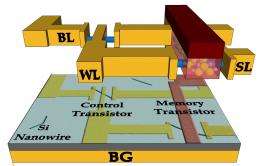New 'FeTRAM' is promising computer memory technology

(PhysOrg.com) -- Researchers are developing a new type of computer memory that could be faster than the existing commercial memory and use far less power than flash memory devices.
The technology combines silicon nanowires with a "ferroelectric" polymer, a material that switches polarity when electric fields are applied, making possible a new type of ferroelectric transistor.
"It's in a very nascent stage," said doctoral student Saptarshi Das, who is working with Joerg Appenzeller, a professor of electrical and computer engineering and scientific director of nanoelectronics at Purdue's Birck Nanotechnology Center.
The ferroelectric transistor's changing polarity is read as 0 or 1, an operation needed for digital circuits to store information in binary code consisting of sequences of ones and zeroes.
The new technology is called FeTRAM, for ferroelectric transistor random access memory.
"We've developed the theory and done the experiment and also showed how it works in a circuit," he said.
Findings are detailed in a research paper that appeared this month in Nano Letters, published by the American Chemical Society.
The FeTRAM technology has nonvolatile storage, meaning it stays in memory after the computer is turned off. The devices have the potential to use 99 percent less energy than flash memory, a non-volatile computer storage chip and the predominant form of memory in the commercial market.
"However, our present device consumes more power because it is still not properly scaled," Das said. "For future generations of FeTRAM technologies one of the main objectives will be to reduce the power dissipation. They might also be much faster than another form of computer memory called SRAM."
The FeTRAM technology fulfills the three basic functions of computer memory: to write information, read the information and hold it for a long period of time.
"You want to hold memory as long as possible, 10 to 20 years, and you should be able to read and write as many times as possible," Das said. "It should also be low power to keep your laptop from getting too hot. And it needs to scale, meaning you can pack many devices into a very small area. The use of silicon nanowires along with this ferroelectric polymer has been motivated by these requirements."
The new technology also is compatible with industry manufacturing processes for complementary metal oxide semiconductors, or CMOS, used to produce computer chips. It has the potential to replace conventional memory systems.
A patent application has been filed for the concept.
The FeTRAMs are similar to state-of-the-art ferroelectric random access memories, FeRAMs, which are in commercial use but represent a relatively small part of the overall semiconductor market. Both use ferroelectric material to store information in a nonvolatile fashion, but unlike FeRAMS, the new technology allows for nondestructive readout, meaning information can be read without losing it.
This nondestructive readout is possible by storing information using a ferroelectric transistor instead of a capacitor, which is used in conventional FeRAMs.
More information: FETRAM. An Organic Ferroelectric Material Based Novel Random Access Memory Cell
ABSTRACT
Science and technology in the electronics area have always been driven by the development of materials with unique properties and their integration into novel device concepts with the ultimate goal to enable new functionalities in innovative circuit architectures. In particular, a shift in paradigm requires a synergistic approach that combines materials, devices and circuit aspects simultaneously. Here we report the experimental implementation of a novel nonvolatile memory cell that combines silicon nanowires with an organic ferroelectric polymer—PVDF-TrFE—into a new ferroelectric transistor architecture. Our new cell, the ferroelectric transistor random access memory (FeTRAM) exhibits similarities with state-of the-art ferroelectric random access memories (FeRAMs) in that it utilizes a ferroelectric material to store information in a nonvolatile (NV) fashion but with the added advantage of allowing for nondestructive readout. This nondestructive readout is a result of information being stored in our cell using a ferroelectric transistor instead of a capacitor—the scheme commonly employed in conventional FeRAMs.
Provided by Purdue University
















